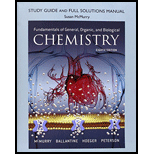
a)
Interpretation: The elements that form only one type of cation to be predicted.
Concept Introduction:
Cation: The removal of electrons from the neutral atom leads to the formation of cation.
Anion: The neutral atom gains electrons leads to the formation of anion.
a)
Answer to Problem 3.29UKC
The Group
Explanation of Solution
The Group
b)
Interpretation: The elements that commonly form anion to be predicted.
Concept Introduction:
Cation: The removal of electrons from the neutral atom leads to the formation of cation.
Anion: The neutral atom gains electrons leads to the formation of anion.
b)
Answer to Problem 3.29UKC
The Group
Explanation of Solution
The Group
c)
Interpretation: The elements that form more than one type of cation to be predicted.
Concept Introduction:
Cation: The removal of electrons from the neutral atom leads to the formation of cation.
Anion: The neutral atom gains electrons leads to the formation of anion.
c)
Answer to Problem 3.29UKC
The transition group, f-block elements and Thallium, Nihonium, Tin, Lead, and Flerovium elements also tend to form more than one type of cation.
Explanation of Solution
The transition group, f-block elements and Thallium, Nihonium, Tin, Lead, and Flerovium elements also tend to form more than one type of cation.
d)
Interpretation: The elements that do not readily form either anions or cations to be predicted.
Concept Introduction:
Cation: The removal of electrons from the neutral atom leads to the formation of cation.
Anion: The neutral atom gains electrons leads to the formation of anion.
d)
Answer to Problem 3.29UKC
Noble gas group, boron, carbon, silicon, germanium, and nitrogen group elements.
Explanation of Solution
The noble gas group, boron, carbon, silicon, germanium, and nitrogen group elements do not readily form either anions or cations.
Want to see more full solutions like this?
Chapter 3 Solutions
Study Guide And Full Solutions Manual For Fundamentals Of General, Organic, And Biological Chemistry
- Chlorine is an element with the symbol Cl. Draw and label atomic structure of chlorine indicating the number and locations of protons, neutrons and electrons in one atom of chlorine.arrow_forwardIf one compound has the formula C5H10 and another has the formula C4H10, are the two compounds isomers? Explain.arrow_forwardWhich of the following levels in the shell model of an atom can hold up to two electrons? A. The second shell B. The first shell C. The third shellarrow_forward
- . Give the name of and symbol for an element with this number of valence electrons.a) 2b) 6c) 8arrow_forwardThe atomic number on an element tells us the number ofarrow_forwardAnother major use of bismuth has been as an ingredient in low-melting metal alloys, such as those used in firesprinkler systems and in typesetting. The element itself is a brittle white crystalline solid. How do these characteristicsfit with the fact that bismuth is in the same periodic group with such nonmetallic elements as nitrogenand phosphorus?arrow_forward
- Elemental analysis of a compound with molar mass 342.3 g/mol gives the following mass percent composition: C 42.11%, H 6.48%, O 51.41%. Find the molecular formula of the compound. Enter your answer in the space below using the following format: if the molecular formula of a compound containing elements X, Y, and Z is X2YZ3 enter your answer as X2YZ3.arrow_forwardA principal shell with a value of n=3 would contain s,p,d, and f orbitals true or falsearrow_forwardHow many electrons does a neutral Chlorine (Cl) atom have in its outermost electron shell?arrow_forward
- What is the difference between molecular mass and formula mass? Between molecular mass and molar mass?arrow_forwardApply the formula for the differences in electronegativities, for the following molecules, and define whether they are polar covalent, nonpolar covalent or ionic. Taking into account that: Non-polar covalent: greater than or equal to 0 but less than 0.7 Polar covalent: greater than or equal to 0.7 but less than 1.7 ionic: greater than 1.7 A)NO B)KCI C)F2 C)AsOarrow_forwardWhich among the four bonds is strongest? And which one is weakess? Explain.arrow_forward
 Principles Of Radiographic Imaging: An Art And A ...Health & NutritionISBN:9781337711067Author:Richard R. Carlton, Arlene M. Adler, Vesna BalacPublisher:Cengage Learning
Principles Of Radiographic Imaging: An Art And A ...Health & NutritionISBN:9781337711067Author:Richard R. Carlton, Arlene M. Adler, Vesna BalacPublisher:Cengage Learning Concepts of BiologyBiologyISBN:9781938168116Author:Samantha Fowler, Rebecca Roush, James WisePublisher:OpenStax College
Concepts of BiologyBiologyISBN:9781938168116Author:Samantha Fowler, Rebecca Roush, James WisePublisher:OpenStax College
 Biology (MindTap Course List)BiologyISBN:9781337392938Author:Eldra Solomon, Charles Martin, Diana W. Martin, Linda R. BergPublisher:Cengage Learning
Biology (MindTap Course List)BiologyISBN:9781337392938Author:Eldra Solomon, Charles Martin, Diana W. Martin, Linda R. BergPublisher:Cengage Learning




